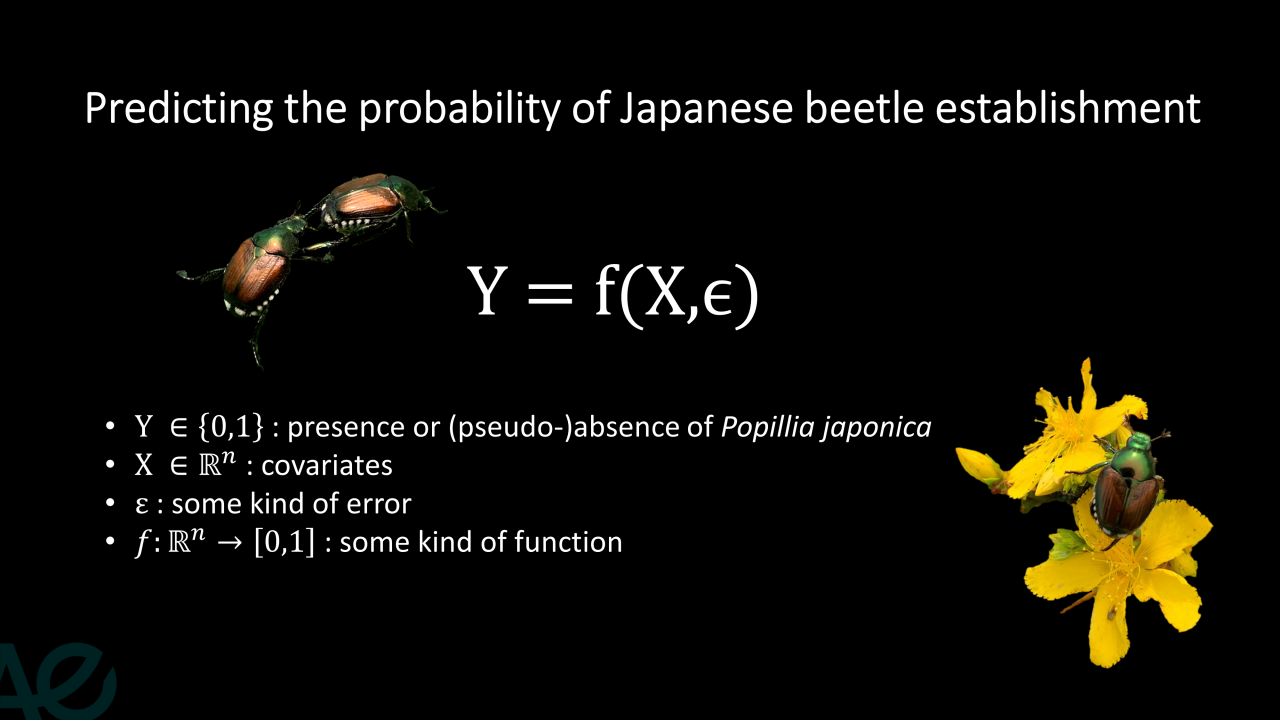As we've said before, a good strategy for early detection of an invasion is to consider the risk of invasion. By modelling the environmental suitability of Europe for the Japanese beetle (Popillia japonica) and therefore the risk of its establishment, our INRAE team has laid the first building block of a surveillance strategy. This work has recently been published (Borner et al., 2023; https://doi.org/10.1127/entomologia/2023/2073) and we describe the main results here.
Is continental Europe suitable for the Japanese beetle to survive and persist in the long term?
To answer this question, we built a database of beetle distribution data and environmental predictors such as climate, land use and soil characteristics. Most of the data on Japanese beetle presence came from the citizen science platform (77%), and some were collected in the field by partners Regione Piemonte and Servizio fitosanitario della Sezione dell'agricoltura (SFTi). Combining these data, we built a species distribution model, calibrated on native and long-invaded areas (Japan, North America and the Azores), which predicts the probability of beetle presence based on local environmental conditions. We assessed the performance of the model in native and long-invaded areas by comparing the predictions with data set aside from the model training. We also compared our predictions with the latest official US invasion status. We then projected this well-calibrated and powerful model to Europe to map the environmental suitability for the Japanese beetle there.
How do I read the suitability maps?
The short version: Suitability maps use 6 discrete classes of suitability, from S0 to S5. Each class is represented by a colour, with darker colours corresponding to higher levels of suitability.
The longer version: These classes are based on a measure of agreement between predicted presence probabilities and observed proportions of occupied sites (where the species is present). This 'fit' is called model calibration. We trained our model and repeated this process 100 times, for a total of 100 models. We used presence data set aside from model training and observed the proportion of occupied sites in relation to the predicted probability of presence. This allows the predictions to be grouped into classes of increasing suitability, so that the predictions reflect an expected chance of the beetle occurring. S0 indicates an environment that is least favourable to the beetle, where all 100 models predict that the beetle is less likely to be present than would be expected by chance. S5 indicates an environment that is most favourable to the beetle, where models predict that Japanese beetle presence is more than 10 times more likely than expected by chance. In between, classes S1, S2, S3, S4 reflect increasing suitability. For these classes, less than half of the models (S1), more than half of the models (S2) and all of the models (S3) predict that Japanese beetle presence is more likely than expected by chance. Finally, for class S4, the models predict that Japanese beetle presence is more than 5 times more likely than expected by chance.
Read more in the methods section of our open access paper.
What are the predictions for the probability of establishment in Europe?
We predicted that 63% of continental Europe would not be suitable for the Japanese beetle in the long term. However, central Europe is almost entirely suitable, with several suitable areas nestled in an area of low suitability (S1). In this low suitability area, the establishment of the beetle cannot be ruled out. The most suitable regions include the current infested area, stretching from the foothills of the Alps to the northern Balkans, and another on the eastern shores of the Black Sea. Similar regions exist in countries such as France, Germany, Austria, Switzerland, Belgium and the Netherlands. Only 1% of these suitable areas are currently infested.
To summarise: Continental Europe is suitable for the Japanese beetle, especially Central Europe. The potential for expansion of the invasion is important, both near and far from the current infested areas.
What does it mean for surveillance strategies?
Estimating and mapping the environmental suitability of Europe for the Japanese beetle allows the likelihood of establishment to be incorporated into surveillance strategies. This gives an idea of how likely it is that the beetle would persist in the long term if it were to arrive in a particular region. This allows sites to be prioritised in surveillance strategies. The suitability maps also highlight the importance of considering passive dispersal in surveillance strategies, which is also part of the INRAE team's work, which was presented at the
ECE Congress.
Find out more:
Borner L, Martinetti D, Poggi S (2023) A new chapter of the Japanese beetle invasion saga: predicting suitability from long-invaded areas to inform surveillance strategies in Europe. Entomologia Generalis 43:951–960. https://doi.org/10.1127/entomologia/2023/2073
Official INRAE releases:






